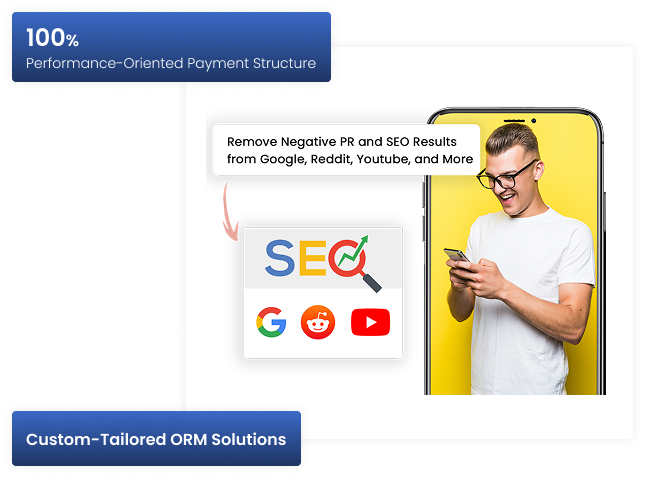
How to Deindex a Page from Google to Manage Negative Content
Have you ever searched your name or business online and found pages you’d rather not see? Those outdated, irrelevant, or sensitive links don’t just sit there – they can harm your reputation and confuse search engines. You might wonder how to fix this, especially if those pages show up in search results.
This is where knowing how to deindex a page from Google Chrome becomes important. You’re not alone in facing this challenge, and you don’t have to tackle it by yourself. At Maximatic Media, we help you take control of your online presence and guide you every step of the way.
Table of Contents
What Is Deindexing and Why Would You Do It?
Deindexing is the process of removing a web page or website from Google Search results so it no longer appears when someone looks for it. It’s like telling Google, “This page shouldn’t show up anymore.” This can be a lifesaver when you’re dealing with sensitive information, outdated content, or duplicate pages that shouldn’t stay public.
You might need to deindex from Google if there’s personal data you don’t want to be visible, such as your address or phone number. Maybe there’s an old page with irrelevant content that no longer represents you and your business. Or perhaps duplicate pages are causing SEO issues, which makes it harder for search engines to rank your important content.
You will gain more control over your online presence if you take steps to remove a page from Google Search. Deindexing helps you keep what matters visible while removing the clutter that doesn’t serve you or your audience.
Deindexing Pages from Your Own Site
Managing your site’s visibility in search results is important to maintaining your online presence. Here are several effective strategies that can help you take control if you want to know how to remove a web page from Google.

Using Google Search Console
Google Search Console is one of the easiest ways to remove a page from Google index. It gives you direct control over your site’s visibility and lets you request the deindexing of specific URLs.
1. Start by signing into your account. You’ll need to verify ownership if you haven’t added your site.
2. Open the Removals tool.
3. Once in the Removals tool, click the Temporary Removals tab.
4. Click New Request and enter the exact URL you want to block. Be precise and make sure that the URL format (e.g., HTTPS or WWW) matches.
5. Choose Temporarily remove URL to block the page from search results for six months.
6. Check back to confirm that the request was approved and the URL is no longer appearing in search results.
Google Search Console is ideal for removing content from Google Search quickly. However, this is a temporary solution, so you’ll need to combine it with other methods for long-term results.
Adding a Noindex Tag
Adding a noindex tag tells search engines to stop indexing a page and make it invisible in search results. This is useful for pages you want to keep live but hidden from search results.
1. Access Your Page’s HTML Code
Open the HTML file of the page you want to deindex. You can do this through your CMS (such as WordPress) or directly via your site’s code.
2. Insert the Meta Noindex Tag
Place the following code in the <head> section of your HTML:
![]()
This instructs search engines to exclude the page from their index.
3. To Block Only Google Crawlers
Use this tag instead if you want to exclude the page from Google’s index only:
![]()
4. For Non-HTML Files
Use an X-robots tag in your server configuration or HTTP headers to block files such as PDFs or images:
![]()
Important: Make sure that the page isn’t blocked by robots.txt, as it can prevent search engines from seeing the noindex rule. You can use Google’s URL Inspection tool to verify implementation.
Using robots.txt
A robots.txt file helps control how search engines crawl your site. Here are the steps if you want to deindex a page using this method:
1. First, you’ll need to locate your robots.txt file in the root directory of your website (e.g.,www.example.com/robots.txt). Use a text editor or your hosting platform to make changes.
2. Next, add a disallow rule by inserting this line into your file:
![]()
![]()
This method is useful for preventing unwanted pages from being crawled, but it has limitations. If external sites link to the page, it may still appear in search results with outdated information.
Permanently Removing Content
To permanently remove a page from search results, you’ll need to start by deleting the page from your server or CMS. Make sure that it returns a 404 (Not Found) or 410 (Gone) HTTP status code, which signals the search engines that the content is gone for good. If deleting isn’t an option, you can restrict access by requiring a password.
Avoid using robots.txt alone, as it doesn’t guarantee deindexing. For previously blocked pages, unblock them temporarily so search engines can see the proper status code or restricted access. This process ensures that search engines drop unwanted pages and effectively help you manage outdated, duplicate, or irrelevant content.
Addressing Cached Versions
Cached versions of a page can stay in search results even after removal or updates. Google’s Refresh Outdated Content tool allows you to address this. Here are the steps you’ll need to take:
1. Visit the Refresh Outdated Content tool. (You must be logged in to use this tool.)
2. Enter the URL of the outdated content, and select the appropriate options to request cache removal.
3. Click “Submit”.
4. If needed, write 1-2 words that are part of the outdated snippet but no longer exist on the page.
5. After submission, your request will appear in the queue at the bottom of the tool.
6. Periodically check back to see the status of your Google removal request.
7. If denied, a link will explain why so you can address the issue and resubmit if necessary.
Google will clear the cached snippet or page from search results if approved. This tool is especially helpful for removing outdated information that lingers even after updates.
Removing Backlinks to the Page
Links pointing to a page can keep it discoverable, even if you’ve tried other deindexing methods. Removing or updating those links reduces the chance of the page being reindexed. You can:
- Check internal links: Search your site for links pointing to the page and update or remove them.
- Address external links: Use tools such as Ahrefs or Google Search Console to find external links. Contact the site owners and request link removal or updates.
By reducing backlinks, you minimize the risk of search engines rediscovering the page and establishing a cleaner and more focused online presence.
Remove Negative Search Results
Remove any negative search results or online press from Google in their entirety.

Deindexing Pages from Other People’s Sites
Removing a page from someone else’s site can feel challenging, but it’s possible with the right strategies. Here’s how you can approach deindexing offending content effectively.

DMCA Claims
A DMCA claim is a powerful solution if the content violates your copyright. You can file a request directly with Google to remove the page from their search results. For instance, Nintendo famously used DMCA claims to protect its intellectual property against fan-made games. To use this method, make sure that the content genuinely infringes your copyright.
Submit a DMCA notice with evidence of the violation. Then, Google will review your request, and if it is valid, they’ll deindex the offending material. Remember that this strategy works best for clear-cut copyright issues or harmful content. Avoid using it for disputes unrelated to legal violations.
Adding a Noindex Tag
Spam reporting and using spammy backlinks are unreliable methods for deindexing content and often lead to negative consequences. Spam reporting involves submitting complaints through Google’s Spam Report Form and accusing the page of spammy content.
Google reviews these manually, and false claims can lead to penalties against you. Spammy backlinks involve flooding a page with low-quality links to trigger penalties, but Google’s algorithms are adept at detecting such manipulation. These tactics can backfire and damage your credibility instead of the target page.
Duplicate Content Across the Web
This strategy involves replicating the content of a target page and publishing it on multiple platforms or sites. The goal is to confuse search engines and make it harder for them to identify the original source.
You can use tools to scrape and copy the page’s content, then post it on forums, low-quality blogs, or social platforms. Small variations may be added to the text to avoid being flagged as direct duplication.
However, Google has advanced systems to verify content sources through timestamps, backlinks, and authority signals. If it identifies your actions as manipulative, the strategy could backfire and leave the target page intact while damaging your reputation.
This tactic is unethical and risks penalties if discovered. Instead of resorting to such methods, focus on ethical solutions.
How to Maximize Your Deindexing Success with Ethical Practices
Combining different strategies is the key to successfully deindexing unwanted pages. For example, use a noindex tag alongside the Google Search Console removal tool to address both immediate visibility and long-term indexing issues. Pair this with updating internal links to reduce the chances of rediscovery.

Similarly, using robots.txt with proper noindex directives ensures consistent results across your site. Combining these methods will give you a reliable solution if you’ve been trying to figure out how to remove a page on Google.
Regularly monitoring search engine results for pages targeting your brand helps you identify problematic content early. This includes examining cached versions of negative pages and taking appropriate action using tools like Google’s “Outdated Content” tool. Proactively filing removal requests or legal takedown notices ensures you address harmful pages swiftly and effectively.
Maximatic Media makes this process seamless. Our expert ORM services can help you remove negative search results and improve your online presence. With proven strategies, we handle everything efficiently and give you peace of mind.
Get in touch
Got a query that Nikolas Lemmel can help you with?
Contact Maximatic Media (Your Partner in ORM)
You need quick and professional solutions when unwanted content threatens your online image. Maximatic Media specializes in helping you take control by offering expert services to deindex negative search results and improve your visibility.

We’ve successfully removed many problematic links for clients like you, whether you’re wondering how to deindex a page from Google, dealing with harmful press, or outdated information.
Our proven process delivers results with no risk, and we offer a 100% refund guarantee. Don’t let negative content hurt your reputation. Contact Maximatic Media today to find out how we can help you improve and manage your online presence.
Frequently Asked Questions
Got questions? We’ve got answers. Check out our FAQ to find quick and detailed solutions to the most common inquiries about our services and processes.
How Do I Deindex a Website from Google?
To deindex a website, you need to block all its pages using a robots.txt file or apply noindex tags to every page. You can also use Google Search Console to remove URLs temporarily.

How Do I Delete a URL Link?
Delete the page from your server and make sure it returns a 404 or 410 status code. Then, use the Google Search Console Removals Tools to speed up the process.

How Do I Get a Page Removed from Google?
Submit a removal request in Google Search Console or apply noindex tags. For external sites, consider filing a DMCA claim or contacting the webmaster.
How Long Does It Take for a Deleted Page to Be Removed from Google?
It can take days to weeks, depending on how often Google crawls your site. Use the URL Inspection tool to speed things up.
How to Remove 404 Pages from Google Index?
Make sure that the 404 status is active for the page, then let Google recrawl it. Using the Removals Tool can help clear it faster.
Check out other Blogs

What Is Search Engine Reputation Management
Although a relatively young industry, the online reputation management sector is …

How to Bury Negative Search Results
As soon as a brand comes under fire for a controversy or a misstep, the internet seems…

How to Master Reputation Management for Your Small Business
The rise of digital platforms, online reviews, and social media has given customers the …

